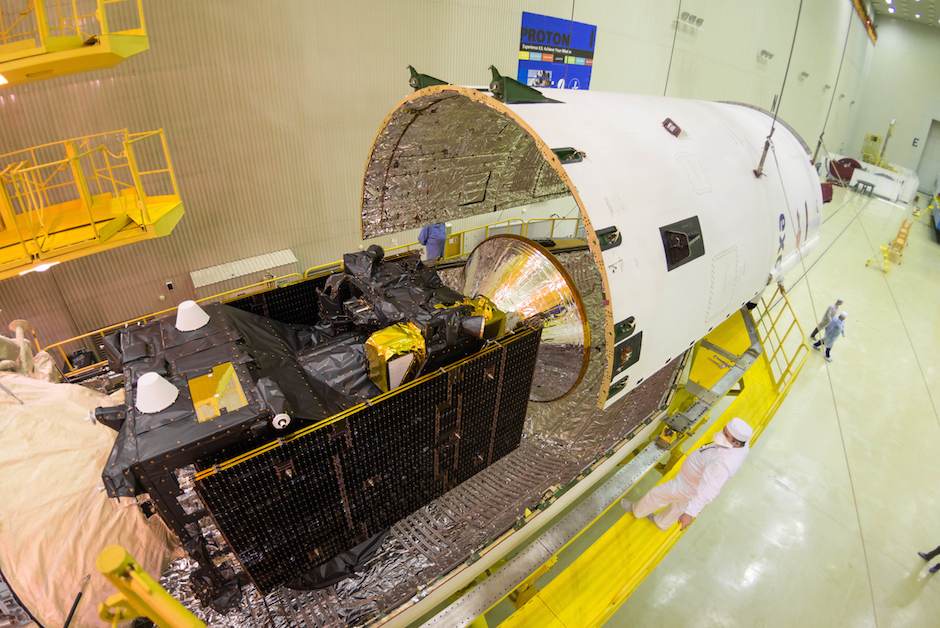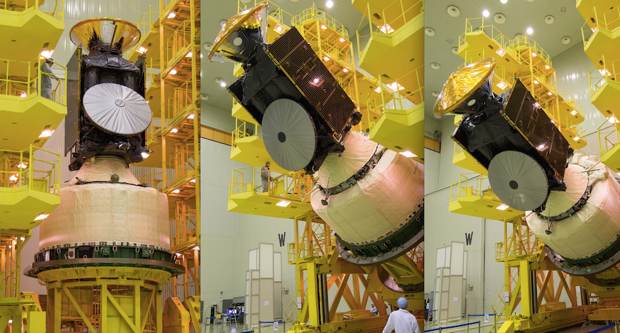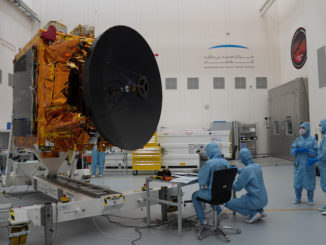
Europe’s ExoMars orbiter was enclosed inside the nose cone of its Proton rocket Wednesday ahead of its March 14 launch toward the red planet to sniff out the source of Martian methane.
The fully-fueled Mars orbiter is Europe’s second mission to the red planet, hosting instruments to take high-resolution stereo images and help map future landing sites, detect and analyze the gases in the Martian atmosphere in greater detail than any previous mission, and prospect for pockets of water ice at and just underneath the planet’s barren surface.
Wednesday’s encapsulation of the ExoMars Trace Gas Orbiter inside the Proton’s 13.5-foot-diameter (4.1-meter) fairing came two days after technicians connected the spacecraft to the rocket’s Breeze M upper stage.
The Breeze M will dispatch the ExoMars spacecraft on a trajectory to escape the bonds of Earth’s gravity, deploying the European Mars probe about 10 hours after blastoff from the Baikonur Cosmodrome in Kazakhstan.
Prior to encapsulation, the ExoMars spacecraft and Breeze M rocket stage were tilted horizontally and ground crews rolled one half of the payload shroud underneath the vehicle. Then a crane lowered the other half of the fairing to enclose the ExoMars orbiter and Breeze M inside, according to an update posted on the European Space Agency’s website.

On Saturday, Russian technicians will connect the Breeze M and ExoMars to the Proton rocket’s three core stages inside the assembly hall at Baikonur.
Next week, the Proton rocket will roll out to a fueling station, then ride a specially-built railroad car to the launch pad March 11. A hydraulic lift will raise the 191-foot-tall (58-meter) rocket vertical, and mobile service gantries will move around the launcher for final preflight checks.
The Schiaparelli lander, a saucer-shaped atmospheric entry probe, is joining the ExoMars Trace Gas Orbiter for the journey to the red planet due to begin at 0931 GMT (5:31 a.m. EDT) on March 14.
The ExoMars mission has a 12-day window to depart Earth and reach Mars in October. Mars launch opportunities come approximately every 26 months, when the planets are aligned to make the trip possible.

The ExoMars orbiter and Schiaparelli lander will disconnect Oct. 16, three days before arrival at Mars.
Schiaparelli will plunge into the rarefied upper atmosphere of Mars at a velocity of 13,000 mph (21,000 kilometers per hour), deploy a supersonic parachute and ignite braking rockets for a landing at Meridiani Planum, an expansive plain currently being explored by NASA’s Opportunity rover.
The battery-powered lander will return data on the Martian atmosphere and weather conditions for up to eight days.
“It will the first mission landing during the global dust storm season,” said Jorge Vago, ESA’s ExoMars project scientist. “We’ll conduct measurements during the descent that will allow us to determine important parameters of the atmosphere, at this time of the year that has not been studied so much.”
Schiparelli, developed by a pan-European consortium led by Italy, aims to become Europe’s first mission to successful land and operate on the Martian surface.

“All of this will feed forward to other missions and our own industry in Europe that may want to try to land also during this time of the year,” Vago said. “Of course, this will be important for future missions, including astronaut missions.”
The ExoMars Trace Gas Orbiter will fire its main engine to slide into orbit around Mars, and later use atmospheric drag to maneuver into a circular pathway about 250 miles (400 kilometers) above the red planet. The spacecraft will collect science data for at least five years, with an emphasis on detecting concentrations of methane in the Martian atmosphere, a key indicator of ongoing biological or geological activity.
The orbiter will also act as a critical telecommunications relay between U.S. and European Mars missions into the mid-2020s, beaming commands and science data between ground controllers and rovers on the surface of Mars.
The launch of Europe’s Trace Gas Orbiter and Schiaparelli is the first half of the ExoMars program. ESA plans to follow up with the launch of a rover in 2018 or 2020 to drill into Martian crust and collect the first subsurface core samples for analysis on the rust-colored world.

Russia joined the ExoMars program in 2012 after NASA pulled out of its commitment to launch the 2016 and 2018 missions aboard U.S.-made Atlas 5 rockets, citing budget constraints. ESA did have funding to launch the missions on European rockets.
NASA was also supposed to build a descent system to ferry the European rover to the Martian surface, a responsibility now assumed by Russia for the next ExoMars mission launching no sooner than May 2018.
Email the author.
Follow Stephen Clark on Twitter: @StephenClark1.



